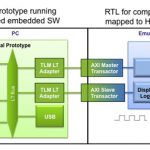There has been a lot of controversy about whether FD-SOI is or is not cheaper to manufacture than FinFET. Since right now FinFET is a 16nm process (22nm for Intel) and FD-SOI is, for now, a 28nm process it is not entirely clear how useful a comparison this is. Scotten Jones has very detailed process cost modeling software (that is what… Read More
Author: Paul McLellan
Hybrid Emulation
Hybrid emulation is when part of the system is run in the emulator and part of the system is run in a virtual prototype. Typically a model of the processor(s) is run in the virtual platform and then the rest of the design is modeled by running the RTL on the emulator. I talked to Tom Borgstrom at Synopsys about what technology they have … Read More
Atmel Licenses Mali and Security from ARM
Atmel (and ARM) announced yesterday that Atmel has licensed a portfolio of ARM IP for devices that require video, image and display capabilities. This portfolio includes Cortex-A7 (a 32-bit core), Mali-V500 (a video accelerator), Mali-DP500 (a display processor) and TrustZone technology (security technology). These can… Read More
The Two Biggest Misses in Mobile
There are some interesting parallels between Intel and Microsoft. Both of them missed mobile. Actually they didn’t completely miss mobile, both of them had programs from early days. But clearly they both regarded mobile as a much lower priority: the PC was where all the money was and where it would continue to be forever.… Read More
Xilinx: Revenue Down, Profit Up, FinFET on Schedule
Xilinx announced their results today and had their conference call this afternoon, which I listened to. For them this is 1Q fiscal 2015 which means you have to be careful since there is a big difference between talking about fiscal quarters and calendar quarters. Xilinx’s conference calls are interesting for a couple of … Read More
Improve Your Memory the Sonics Way
There is never enough memory bandwidth. Well, occasionally there is but many SoCs have lots of blocks that communicate through memory, typically off-chip DRAM. In 2001 Sonics created their first solution to this problem with MemMax technology that was incorporated into their SonicsSX product. This has been used in over 100 designs… Read More
Cadence Results: Good but Palladium under Price Pressure
Cadence announced their 2Q results this afternoon. I listened to the conference call.
You can read all the details of the results in the press release but the big picture is:
- Revenue $379K, net income $23M GAAP or $64M non-GAAP (8, 21c per share, beat estimates by 1c). Equivalent quarter last year was $362M so less than 5% increase)
New Release of Semulator3D at #semiconwest
One of Coventor’s flagship products is SEMulator3D, and at Semicon West they announced a new version, 2014.100.
SEMulator3D is a powerful 3D semiconductor and MEMS process modeling platform. It uses highly efficient physics-driven voxel modeling technology. It models the physical effects of process steps, which is… Read More
eSilicon and IDT Collaborate on Next-generation RapidIO Switches
Earlier in the week, eSilicon and IDT announced a collaboration to accelerate development of next-generation RapidIO switches. These are used to meet the higher performance demands required for new wireless, embedded and computing infrastructures. The two companies will initially work together to develop RapidIO switches… Read More
Palladium’s Little Brother Protium
Today, Cadence announced Protium, a new FPGA prototyping platform for software development. During development of an SoC, the most appropriate methodology changes. In the early days, developing RTL, the primary tool is simulation. Then, as the blocks get bigger or as the whole chip starts to come together, typically simulation… Read More












AI RTL Generation versus AI RTL Verification